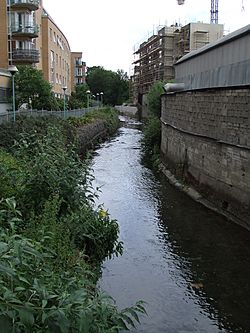River Camac facts for kids
Quick facts for kids River Camac |
|
|---|---|

Camac River looking south at Inchicore by "The Tramyard" development
|
|
| Country | Ireland |
| Region | Dublin Region |
| County | South Dublin, Dublin |
| Physical characteristics | |
| Main source | Mount Seskin, Slade of Saggart |
| River mouth | River Liffey at Heuston Station, ultimately Dublin Bay |
| Basin features | |
| River system | River Liffey |
| Tributaries |
|
The River Camac is one of the larger rivers in Dublin, Ireland. It was very important for the early growth of the city. Its name can also be spelled Cammock, or in Irish, An Chamóg. The Camac is one of four rivers that flow into the Liffey.
Contents
Where the Camac River Flows
The Camac River starts from streams on Mount Seskin. This mountain is southeast of Saggart, in the southwest of Dublin city. In the 1700s, some water was also directed into the Camac from the Brittas River. The Brittas River is another stream that flows into the Liffey.
Journey Through Valleys and Parks
The river flows through a mountain valley called the Slade of Saggart. This area is southwest of Tallaght and east of Newcastle. It then passes through Saggart and Kingswood. The river even goes under the N7 road.
Next, the Camac flows through Kilmatead. Here, you can find a small lake with islands. From there, it enters Corkagh Park. This park used to be a large estate. For hundreds of years, the river's water was used to power local mills.
Ponds and Mills Along the River
There are two ponds behind Kilmatead. Corkagh Park has a new pond for fishing. You can also see the dry bed of an old pond near the Fairview Oil Mill ruins. Further downstream, near Moyle Park College, water from the Camac was used by the Clondalkin Paper Mills.
Many of these old concrete ponds are now in poor condition. This is because water levels have dropped, and mud has filled them up. Another mill pond, which served Leinster Paper Mills, was once on Nangor Road. However, it was covered up to make space for a car park. This car park is now part of the Mill Shopping Centre.
Flowing Through Dublin's Suburbs
The Camac continues its journey through Clondalkin village. It flows past the Garda Station and down Watery Lane. The river then heads towards Nangor Road. In the industrial areas of Bluebell and Robinhood Estate, other streams join the Camac.
After that, the river travels through the Lansdowne Valley. It then reaches the residential areas of Drimnagh and Crumlin.
Reaching the Liffey in the City
The river goes on to Inchicore. Here, it flows through a tunnel under the Grand Canal. It then crosses under a bridge at Golden Bridge. The Camac runs behind Richmond Park. This is the home stadium for the football team St Patrick's Athletic. The stadium even has a section called 'Camac Terrace' named after the river.
Finally, the river reaches Kilmainham. It flows behind the famous jail museum. The Camac then enters the Liffey next to Heuston Station. This is a little bit upstream from the Sean Heuston Bridge. When the railway station was built in 1846, the river was covered over to go underneath it.
Streams Joining the Camac
Many smaller streams flow into the River Camac along its path. In the Slade of Saggart, it gets water from the Ferny Glinn and the Two Slades. Other streams join near Newcastle and Clondalkin. These include the Boherboy, Brownsbarn, and Fettercairn Streams. The Fettercairn Stream joins near Corkagh Park.
Further downstream, other important streams add to the Camac. These are the Robinhood Stream (also called Coolfan River) and the Gallblack Stream. The Gallblack Stream itself is formed from the Blackditch and Gallanstown Streams. The Drimnagh Castle Stream (or Bluebell Stream) and the Walkinstown Stream also join the Camac.

